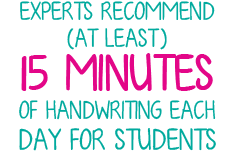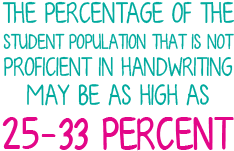
The Mission
Why Fight For Your Write with BIC?
Join BIC on our mission to celebrate handwriting and Fight For Your Write. Writing is an important vehicle for communication because it distinguishes us and promotes individuality. Did you know that writing is also a critical learning tool for children? Writing helps kids become better readers, boosts their confidence and sparks their creativity. Together we want to show children just how great writing can be... and how great they can be!

Watch Our Video!

Experts recommend at least 15 minutes of handwriting instruction each day for students. Research has shown that improved handwriting skills have benefits for cognitive development, motor skills and can lead to improved writing skills and comprehension.
Source: Hanover Research (2012). The Importance of Teaching Handwriting in the 21st Century. Washington, DC: Hanover Research"Studies show that children who write frequently, both at school and at home, feel more confident in their writing abilities. This confidence translates into success in all academic subjects and in nonacademic environments as well." – Pam Allyn, Your Child’s Writing Life and "Prepare My Child for School: Early Childhood Education," U.S. Department of Education.
Handwriting builds a solid foundation for school success. Research shows that handwriting is a foundational skill that can influence student’s reading, writing, language use, and critical thinking.
Learn MoreResearch has proven that there is a positive correlation between better handwriting skills and increased academic performance in reading and writing. When students spend less time concentrating on the basics of letter formation, "students can better focus on the planning and thought organization that is required for effective composition."
Learn MoreAccording to an expert in educational psychology from the University of Washington, handwriting instruction benefits students' cognitive development as well as motor functioning. For example, some of the motor and cognitive tasks associated with handwriting are the following: ideation, text production, punctuation, planning, spelling, grammar.
Source: Hanover Research (2012). The Importance of Teaching Handwriting in the 21st Century. Washington, DC: Hanover ResearchIn terms of students’ cognitive development, evidence-based research has shown that handwriting skills can influence reading, writing, language and critical thinking.
Learn MoreHow Handwriting
Can Make
YOU Awesome!

Know The Facts:

had college-level courses that prepared them to teach handwriting
grades 4-12 were writing below grade level on a national writing exam
were unprepared to write at a college level



Handwriting engages 14 different abilities

1) Visual Focusing
2) Mental Attention
3) Organized Physical Movements
4) Receptive Language
5) Inner Expressive Language
6) Memory Recall
7) Concentration with Awareness
8) Spatial Perception
9) Organization
10) Integration
11) Eye-Hand Coordination
12) Motor Planning
13) Tactile Input
14) Crossing Midline



